2013.07.25 08:16
Traditional/Classical Architecture- Part 2
There's a very interesting relationship between the architecture of Strickland and Schinkel. For example, compare the (space-time) of the Neue Wache and the Second Bank of the United States. Did they know of each other's work? I have no idea, but the space-time similarities are sometimes uncanny. Did they just happen to have access to (and devour) the same books and 'magazines'?
Koolhaas/OMA has been steadily building upon the components of architecture's tradition of the last 100 years or so.
The more traditions stay the more they change the same?
2013.07.25 11:29
Traditional/Classical Architecture- Part 2
Personally, I would like a truly eclectic house...

...showing my love of all architectur[al education].
2013.07.25 08:29
Charles Jencks - The Story of Post-Modernism: Five Decades of the Ironic, Iconic and Critical in Architecture
But 'the story' of Post-Modern architecture indeed comprises multiple narratives, conflicting viewpoints, and subaltern voices. From the very beginning Jencks described the language of Post-Modern architecture as schizophrenic, even.
2013.07.30 14:15
30 July
Finished reading Log 28 this morning--been reading it since last Thursday. Also been thinking of starting a thread about it--Stocktaking 2013. In any case, there are many passages worth remembering and even discussing. For example (and off the top of my head), Kipnis saying very similar things vis-à-vis (a comparing of) Gehry and Schinkel; PVA lamenting 'destruction' via tweets, Lynn now working in 'isolation', Diller meeting a non-architect that took Venturi's history class and said it was the best course he ever took; AZP's personal CAD history; what Whiting described as 'evil'; etc. There's also the almost invisible veil of fear that postmodernism may not be dead.
2013.08.15 16:44
Art vs. architecture
Looks like my next project is to design a Comfort Zone Inn. Here's the program:
The Comfort Zone Inn is a behavioural state within which a person operates in an anxiety-neutral condition, using a limited set of behaviours to deliver a steady level of performance, usually without a sense of risk. A person's personality can be described by his or her comfort zones within a Comfort Zone Inn. A Comfort Zone Inn is a type of mental conditioning that causes a person to create and operate mental boundaries. Such boundaries create an unfounded sense of security. Like inertia, a person who has established a comfort zone in a particular axis of his or her life, will tend to stay within that Comfort Zone Inn without stepping outside of it. To step outside their Comfort Zone Inn, a person must experiment with new and different behaviours, and then experience the new and different responses that occur within their environment.
| |
2013.08.18 11:44
Why do you think you're creative?
I'm just starting to read a collection of critical essays on James Joyce, and so far it's interesting to see how Joyce's unique creativity seems to induce a creativity from the essayists that they might not normally have. I've sometimes noticed a similar effect when reading critical essays on Duchamp. Philippe Duboy's Lequeu: An Architectural Enigma is perhaps the apotheosis of this kind of critical effect creativity.
Is it then a fair hypothesis that one's critical deliberation of a unique creativity might well engender an as yet uncommon creativity from oneself?
2013.09.17 09:54
Video from Jacque Herzog's Columbia Lecture
In referring to the four inserted 'anchor' spaces of the Espacio Goya project, new spaces which replicate other (original) spaces throughout Spain that contain in situ murals painted by Goya, Herzog more than once used the word 'reconstituted.' To reconstitute means "to build up again by putting back together the original parts of elements." Since the original spaces are still entact, the proposed 'anchor' spaces of the Espacio Goya design are not a reconstitution. The correct word to describe the four 'anchor' spaces of the Espacio Goya is reenactment, as in, the four original spaces that contain Goya murals are enacted again at the Espacio Goya.
In separate contexts and almost just in passing, Herzog described both Stirling and Rossi as having "lost their [architectural designing] way" [as their careers matured]. This caught my attention because it is exactly the "lost ways" of Stirling and Rossi that have interested me the most over the last 30 years. Sixty years ago, many critics thought Le Corbusier 'lost his way' with Ronchamp, yet it is exacly the late (unexecuted) work of Le Corbusier that is now often a paradigm for current architectural works (including some works by Herzog and de Meuron).
Right now I'm wondering what projects will (or already do) indicate Herzog and de Meuron having lost their way. Perhaps Actelion Business Center is a leading indicator, or maybe it's the purposefully mis-described 'anchor' rooms of the Espacio Goya.
2013.10.03 21: 50
Why we create
Perhaps it's just semantics, but architects for the most part design; few architects actually also create.
Although, I suppose you can call a design a creation, especially if the design is never executed into built form.
I guess the point I really want to make is that most of what architects do is not actual creation, rather virtual creation.
2013.10.06 11:35
6 October
Read earlier: "...locale and history have simultaneous real and fabled coordinates, anchored both in actuality and in the archetypes of innocence and experience, paradise gained and lost... ...the reader enters a fictive world with its own unique operating principles, in which past and future conjoin to form a continual present in which the extraordinary meet the commonplace to defamiliarize and release an aura of strangeness and wonder... ...traditional oppositions--realism and fantasy, fact and illusion, history and myth, reason and irrationality--coming together in a complex of significance."
| |
2013.10.10 12:53
10 October
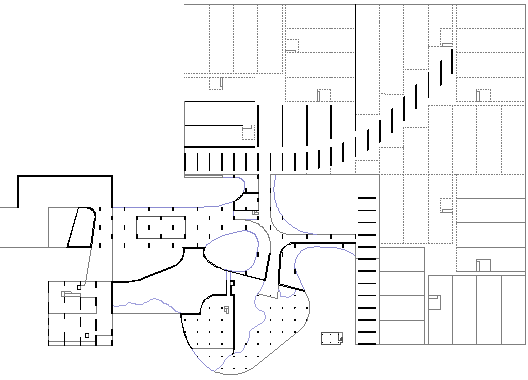
Since yesterday, I've been working on two Quondam projects simultaneously: First, there's [re]drawing the plans (above) of Le Corbusier's Electronic Calculation Center Olivetti at Rho-Milan (1963-64). Second, there's the compilation of Maison Dom-ino data (Le Corbusier, 1914) within Quondam's collection. The Maison Dom-ino plan is shown below relative to the Olivetti Center plan.
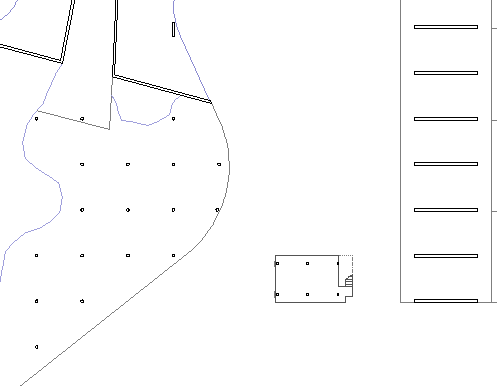
A CAD model of Maison Dom-ino has been part of Quondam's collection since 1991, and the present data compilation process is to record and exhibit how and why Maison Dom-ino is a part of Quondam's collection, and how Maison Dom-ino continues to spur on new data within the collection.
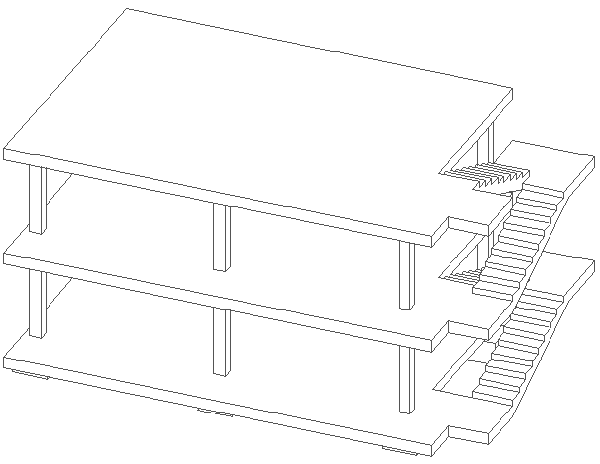
It was not until this morning, however, that Maison Dom-ino and Electronic Calculation Center Olivetti data have been combined.

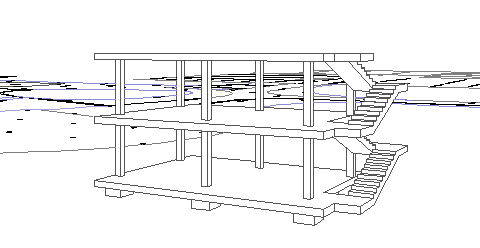
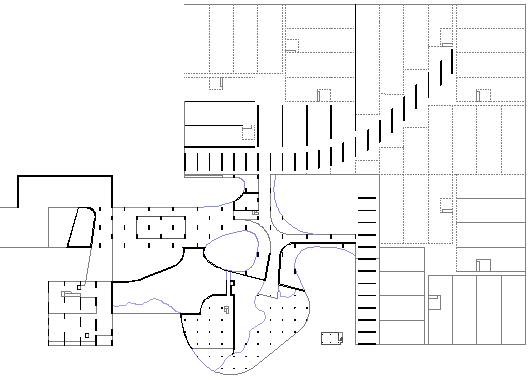
You could say Maison Dom-ino and Electronic Calculation Center Olivetti respectively represent the beginning and the end of Le Corbusier's architectural career--a span of almost exactly 50 years. Strange, too, to realize that the Electronic Calculation Center Olivetti design itself is now 50 years old, and that Maison Dom-ino will be 100 years old next year. I want to write something about how the plans seen together demonstrate an intense evolution in Le Corbusier's design thinking/ability, if not also an intense evolution of modern architecture itself. The plans more or less 'speak' for themselves, but bear in mind that the Olivetti design, for the most part, still adheres to the Maison Dom-ino paradigm of column support, slab, and independent circulation. Moreover, the Olivetti design is a composite of the various design directions the Maison Dom-ino paradigm is capable of going into.
I'll stop now, but obviously there's a lot more here to consider, not least of which is whether the past 50 years of architecture['s evolution] even relates to the Maison Dom-ino paradigm anymore.
|